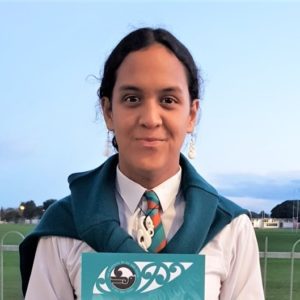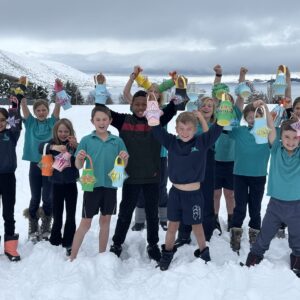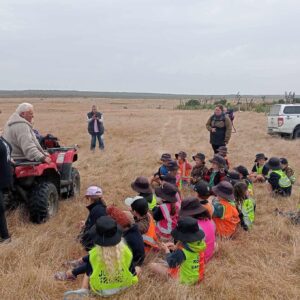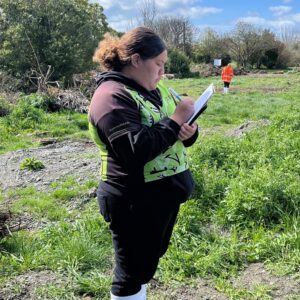



Ko Manawaru, Matiti, Maungahaumia, Ahititi, Hikurangi me Rangipoua ngā maunga.
Ko Te Ārai, Maraetaha, Waipaoa, Waihirere, Waiapu me Hāparapara ngā awa.
Ko Horouta, Tākitimu me Mātaatua ngā waka.
Ko Manutuke, Muriwai, Mangatu, Parihimanihi, Whareponga, Tū Auau me Otuwhare ngā marae.
Ko Ngāti Kaipoho, ko Rangi i Waho Matua, ko Ngāti Taua, ko Ngāti Kohuru, ko Te Aitanga-a-Mate, ko Ngāti Rangi, ko Te Whānau-a-Rutaia ngā hapu.
Ko Rongowhakaata, ko Ngāi Tamanuhiri, ko Te Aitanga a Mahaki, ko Ngāti Porou, ko Te Whānau-a-Apanui ngā iwi.
Ko Kiana Ria Renata-Kokiri toku ingoa. 17 oku tau. Ko Manutuke taku tūrangawaewae.
Child of the mist, Tame Iti, says that “history has woven us together. We are the basket, the kete, that holds the future!”
As a young Māori woman, I have experienced both mainstream and kura kaupapa education. School is often a difficult and confusing time for me. I often question its purpose. Referring to our country’s curriculum, Dr Muriel Newman states that “the vision statement affirms that young people will work to create an Aotearoa New Zealand, in which Māori and Pākeha recognise each other as full Treaty partners.” I don’t believe this statement has any truth. Even in the kura kaupapa setting in which I currently learn, the effects of colonisation are clearly visible.
Disappointingly, neither the mainstream system or kura kaupapa adequately prepare me with the right values to become a great leader for our future, or the right tools to assist me in doing this. Rather, it restricts and tries to manipulate me to think, speak and behave a certain way. Supposedly sculpting me to be the “best person I can be”, when really it is failing me, trying to conform me to fit within the one size fits all mentality that society imposes on me.
Despite these challenges, I am reminded by political activist Tame Iti that “we don’t always have to agree; mana can be tested, even challenged, but with respect and an understanding of one another’s mana.” Now I challenge you to open your minds and your hearts and allow yourself to feel the words I share with you. Visualise the world through my eyes as a leader of the future generation!
Visualise the world through my eyes as a leader of the future generation!
In addition to my parents, I have been nurtured and raised by the extended branches of my family tree. My grandparents and my great grandparents. My aunties and my uncles. Even life amongst cousins provides important learning and experiences for me. As the saying goes, “it takes a village to raise a child” and I am fortunate enough to say that this is me. Dr Mason Durie’s Te Whare Tapa Whā model states that a healthy whānau reflects the importance of healthy relationships, connections and social well-being.
Home is also where I have spent much of my life. Life for me here consists of stories of our past, present, and future. The good and the bad. My tipuna, my mountains, my rivers and my tūrangawaewae, my place of belonging. I understand why everything that I have been taught is important, and why it is important to me. These aspects of my life create the foundation of what shapes me, and of what shapes my culture.
“Culture” is a way of life which is formed by groups of subcultures. With each subculture comes a set of values that are important to me, and with each set of values comes behaviour, positive or negative. The outcomes for me are a direct result of the behaviours I display. There is always room for growth. Home is a place which supports me to be the best version of me that I want to be, to lead us in the future. I am sure in the knowledge of who I am and where I am from. You can count on me to lead the way.
Life for many youth today is vastly different to the life I am fortunate enough to be exposed to at home. Through studying Dr Mason Durie’s “Principle of Indigeneity”, learning about my identity as a young Māori woman has enhanced my determination to retain my own cultural identity, avoid assimilation, and exercise a degree of autonomy.
I don’t believe that school has taught me this. Home has been my classroom. This is the very reason why I say the education system is failing me. How can I succeed within the future without first understanding who I am and from where I am from?
How can I succeed within the future without first understanding who I am and from where I am from?
I feel that many taiohi are missing out on a life of understanding and knowing who they are as a result of societal influences – for example, social media, technology and money. I believe that it is getting in the way of what matters most to us as Māori. We have some of the poorest health statistics in our country, not to mention our people have the highest statistics in crime. Why? Because societal influences have corrupted our minds and our way of life. I believe this is causing a certain disconnection for Māori to te ao Māori, to our whakapapa, to our identity. Some rangatahi may disagree, but I believe that these very things should be integrated into our everyday school life before it is too late.
You’re probably wondering what this would look like. Well, let me show you.
Physical education (P.E.) in a mainstream and kura setting is about healthy lifestyles – nutrition and exercise. However, it shouldn’t be. Other than Ki-o-rahi, we don’t have much as tauira Māori to link back to – right? Wrong! P.E. can and should incorporate mau rākau, ngā āhae, nekehanga, tī rākau, pakiaka and other various traditional Māori games that many rangatahi do not know – like poi toa, hopu ariki, pōtaka etc. In addition to the art of our traditional ways will follow the understanding of the rich history that lies beneath the surface of these tāonga – their purpose, stories, disciplines, skills, values, creativity, application, communication skills and so forth.
Kapa haka. Many of us today only seem to practice this art form for the performance element. We should have set akoranga for this. In these akoranga we would learn the basics and disciplines of takahi and wiri, the tikanga behind them and why they are important. Not just for “stage presence”, but to understand why we as Māori do this. Waiata kīnaki, waiata tawhito and their whakamārama. Ideally, kapa haka would be a subject in which Māori students can excel in the ways of haka as our ancestors did, not for the purpose of drama, performance or theatre.
As a result of colonisation, learning for Māori has become confined and limited to the walls of a classroom.
Wānanga ao te pō, pō te ao. Tāne mai, wāhine mai. We’d all be learning our part to play, to live, in te ao Māori. As a result of colonisation, learning for Māori has become confined and limited to the walls of a classroom. Our people have never been those type of learners. We are naturally kinaesthetic learners, better at learning by “doing the do”, rather than sitting there being lectured to. Marae (pā) based learning in our own environment would provide many benefits: learning how to work at the back and in the kitchen, perhaps the art of whaikōrero and karanga at the front. Whatever the lesson, there’s always a place on the pā to learn it, and most of the time someone to teach it. After all, our marae only run like clockwork with “te Amorangi ki mua” and “te hāpai o ki muri”.
How many rangatahi partake in activities on their marae? How many can confidently work roles on their marae? It is probably safe to say there would be a higher number of “foreign” rangatahi to marae than there would be “born’n’bred pā kids”. My Pāpā has always shared that the marae was the social hub in his day. Sadly, today is its contrast. Our marae are often cold and lonely, with barely any sign of life. Society is impacting hugely on the traditional ways of our people, as we sit by and watch.
Science. Our people were natural scientists. We knew how to live off the land, but provide for it too. We were natural environmentalists. Kaitiaki of our whenua. Science today is not a popular subject for many rangatahi. Science looks like microscopes, test tubes and a whole lot of text books with words I don’t understand. We should be out amongst our communities, connecting with those of our people who still know and still are kaitiaki of our whenua. The people who still live off and provide for the land.
Challenge the system, knowing that the system isn’t working for us. Challenge yourselves as educators to think outside the square.
So there we have some solutions. But how do we “walk the talk”? That’s where you come in, and I hope is why you are here today. Take the plunge and challenge yourselves as Māori educators to make a difference for me, and for many of our rangatahi struggling in today’s society. Many of you (and our kaiako Māori) are qualified teachers, but qualified by whose standard, I ask? A qualification which belongs in a colonised system, might I add; a qualification that has boxed many of our kaiako and their thinking, confined it to the ways of the colonised system. So what can you do to help? Challenge the system, knowing that the system isn’t working for us. Challenge yourselves as educators to think outside the square. Challenge yourselves to recreate the system to fit with the examples and solutions I have provided, or at least find how the current one can be manipulated to fit a way of learning that is better for us, better for Māori. Challenge yourselves to develop and upskill in the traditional ways of our people, and challenge yourselves to open the doors to those who would be best suited to teach us until you get it together. Those people like our Pāpā, our Nannies, even our surrounding aunties and uncles.
I believe that going back to learning like those of our old people is the way to go. What learning for tauira Māori should look like. This ara of learning I trust will connect us to our identity, understanding who we are and where we come from. Knowing our place in the world so we can stand confidently as tangata whenua. Enabling us to live in today’s society in our difference, our strength and in ourselves as Māori. Developing ourselves to ensure sustainability for our future. I conclude that this is what is necessary to be able to walk confidently in both worlds. But most importantly, so that we can say, “He Māori au, e noho Māori nei i tōku ao Māori – I am Māori, and I live in my Māori world!”
Nō reira tēnā koutou, tēnā koutou, tēnā tātou katoa.
Kiana Ria Renata-Kokiri, of Tairawhiti whānui, is a student at Te Kura Kaupapa Maori O Nga Uri A Maui. She performed this speech at the 2018 Pae Tawhiti: Beyond the Horizon – Maori Education Leadership Conference in Gisborne, and we are honoured to reproduce it here.
Related Posts

From making lanterns and sharing kai to discos, art auctions and kapa haka, there are many different ways to celebrate Matariki and Puanga. Ako asked five kura from around Aotearoa how they mark this special time of year.

Working at a school on the Chatham Islands demands resilience, innovation and a deep sense of connection. Kirsten McDougall spoke with staff at Te One School to find out what it means to educate in one of the most remote communities in Aotearoa.

At Arakura School in Wainuiomata, Lower Hutt, lunchtime isn’t just about food – it’s about community, connection and learning. Instead of outsourcing school lunches, staff and tamariki grow, prepare and serve nutritious kai together. The entire school gathers each day to share a meal, turning lunchtime into a rich learning experience.

How can educators tautoko and empower young people to feel equipped to lead in the changing climate they will inherit? Researchers from the University of Canterbury and Ngāi Tahu have been working with rangatahi Māori and Pasifika in Ōtautahi to explore the ways ākonga view climate change. Ako finds out about the project.